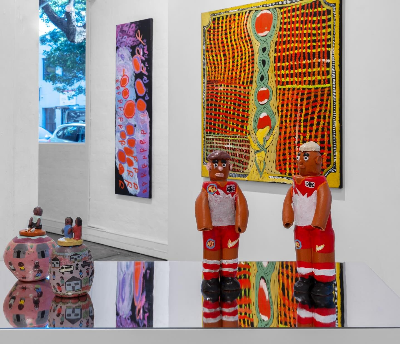
© Facbook Arthouse Gallery
У Сіднеї розголос отримала виставка «Rehla Kurrka», яка демонструє, перетворення традиційного мистецтва аборигенів на сучасну форму вираження — живу, емоційну і сповнену гумору. На відкритті Біллі Бейн, відомий австралійський художник з даруг, розповів про свій досвід роботи з майстрами та показав, як фігурки стають містком між культурною спадщиною та сучасним мистецьким контекстом. Фігурки оживають на виставці: це керамічні персонажі з тонкими деталями, що відтворюють сцени повсякденного життя, комічні моменти та міфологічні мотиви. Один із улюблених експонатів показує старшого чоловіка, який грайливо ховає капелюх за спиною дитини — маленька деталь, що передає гумор і життєрадісність спільноти. Інші роботи поєднують традиційні форми з сучасними алюзіями: персонажі спостерігають за колоніальними постатями, тварини з надвеликими очима підкреслюють абсурд стереотипів, а деталі побуту оживають у мініатюрних інсталяціях. Критики відзначають, що ці фігурки — не просто декоративні об’єкти, а сучасна художня мова аборигенів, що через гумор, символіку та дотепність відкриває історії свого народу для нових аудиторій. Поціновувачі підкреслюють унікальність поєднання майстерності та актуальної тематики, де традиція стає сучасним мистецтвом, а культурна спадщина оживає на очах глядача.
“Rehla Kurrka 2025”: Contemporary Aboriginal Art of Australia
In Sydney, the exhibition “Rehla Kurrka” has attracted widespread attention, showcasing the transformation of traditional Aboriginal art into a contemporary form of expression—vivid, emotional, and infused with humor. At the opening, Billy Bain, a renowned Australian artist from the Dharug people, shared his experience working with the artisans and demonstrated how the figurines serve as a bridge between cultural heritage and the contemporary art context. The figurines come to life on display: ceramic characters crafted with fine detail, depicting everyday scenes, comic moments, and mythological motifs. One favorite exhibit shows an elder playfully hiding a hat behind a child’s back—a small detail that conveys the humor and joyfulness of the community. Other works blend traditional forms with modern references: figures observing colonial figures, animals with oversized eyes emphasizing the absurdity of stereotypes, and domestic details animated in miniature installations. Critics note that these figurines are not mere decorative objects but a contemporary Aboriginal artistic language that, through humor, symbolism, and wit, reveals the stories of their people to new audiences. Enthusiasts emphasize the unique combination of craftsmanship and topical themes, where tradition becomes contemporary art and cultural heritage comes alive before the viewer’s eyes.
1154